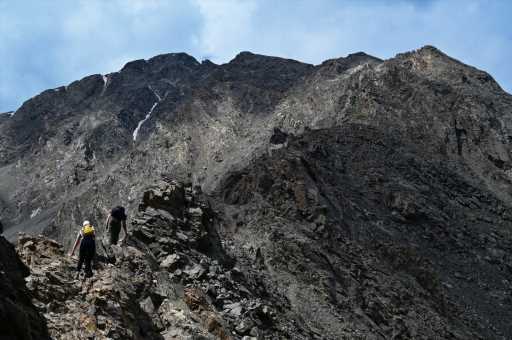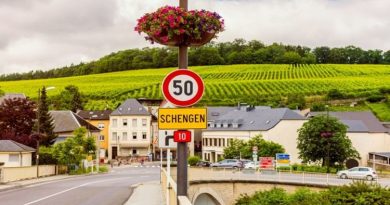Users beware: Trail apps have been leading to problems in public lands
Veteran mountaineer Dale Atkins was climbing the challenging Kelso Ridge last week on Torreys Peak, a popular Front Range fourteener, when he encountered a woman in her 20s who had discovered the complexity of the climb required route-finding skills beyond her experience level.
“She said she’d gotten to one of the harder spots and just couldn’t figure out where to go, so she turned around,” said Atkins, a member of the Alpine Rescue Team, a volunteer search-and-rescue group that conducts missions in Clear Creek, Jefferson and Gilpin counties.
“I asked her if she was using an app, and she said, ‘Yes, I was using AllTrails,’” he continued. “She said all the reviews were really positive about the climb, so she figured with three fourteeners under her belt that she could do it. Her ambitions just exceeded her experience.”
Atkins wasn’t surprised. The popular hiking app, with its digital trail maps and user-generated reviews, is the go-to source for many Colorado hikers. But it doesn’t provide a lot of detail in describing complicated climbs like the Kelso Ridge, which is visible from Interstate 70, five miles west of Silver Plume. He and the Alpine Rescue Team had been there before, responding to other climbers who’d gotten stuck on the route while using trail apps and needed to be guided out.
Public land managers across the country are discovering the shortcomings of crowdsourced apps like AllTrails and Gaia GPS, which show where trails are on digital maps, and provide user-generated feedback and reviews, but leave hikers wanting for specific route details. There are other issues, as well, such as leading hikers to trails that are closed or cross private land.
It has become enough of a concern, in fact, that government agencies like the National Park Service, the U.S. Forest Service and the Bureau of Land Management have been meeting with these companies and others twice a month for the past two years to talk about solutions.
“It is an issue that we’ve been dealing with in the forest service for a little while now, trying to better understand how we can address it,” said Chad Schneckenburger, trails manager for the Rocky Mountain Region of the USFS. “For us, it’s really a management challenge. All those apps are crowdsourced. It’s essentially user-generated information.”
For Atkins, the issue on trails like the one on Kelso Ridge is with users not understanding the limitations of the apps, especially inexperienced hikers.
“It’s not an AllTrails issue per se,” he said. “Even if she’d had a regular topo map, it would tell her where to go, but it doesn’t tell her how to get through the terrain. The limitations are not necessarily with the apps, they’re in people’s abilities to perceive the terrain around them.”
The working group created to improve the data behind trail apps was spearheaded by Maggie Cawley, the executive director of OpenStreetMap US, the U.S. chapter of an international nonprofit that is a primary source for AllTrails and other apps. OpenStreetMap, which is built with crowdsourced information, is sometimes called the Wikipedia of maps.
Cawley was contacted two years ago by Keri Nelson, then a National Park Service backcountry coordinator for southeast Utah who reached out to report problems caused by trail apps that she was seeing in Canyonlands National Park near Moab. Cawley asked Nelson to give a presentation to a virtual meeting of folks in the mapping community hosted by OpenStreetMap US.
“What we were seeing in the park was, people would add trails or trail systems that aren’t official designated park trails, but they looked like it on the (trails app) map,” said Nelson, now an outdoor recreation planner for the Bureau of Land Management in Moab. “That was causing problems, because people would see these trails, or this data on a map platform, that looked like they were trails. When you see it on a map, a lot of us would expect on the ground that there’s going to be a well-defined, maintained trail there, which often was not the case with these user-added trails.”
Schneckenburger was seeing similar things happening in the forest service’s Rocky Mountain region, which includes 17 national forests and seven national grasslands in Colorado, Kansas, Nebraska, Wyoming and South Dakota.
“The issue we were seeing from a management perspective was, when trails information was being reflected on a lot of these third-party apps, there wasn’t anything to distinguish between what is an official forest service system route that we maintain — that we would publish on our own maps — versus user-created social trails,” said Schneckenburger, whose office is in Lakewood. “They were being displayed all the same on a lot of these apps.”
Resource impacts and intrusions onto private land aren’t the only issues. There are visitor safety concerns, too.
“Not everyone who visits national parks is well-versed or experienced in backcountry travel,” Nelson said. “They are relying on these maps to give them data that is supposed to be reliable, which is not necessarily the case.”
After Nelson finished her presentation, Cawley floated the idea of creating the working group to tackle the problem. “I asked everybody in that meeting, ‘Would you want to meet again and see how we can help support this? We need AllTrails in the room. We need the forest service, the national parks, and we need the mappers.’ People said yes, and we’ve been meeting twice a month for two years.”
One goal is to create mechanisms to give land management agencies greater ability to correct misinformation or provide timely updates, such as temporary trail closures.
“We just can’t control what data comes on these private apps,” Schneckenburger said. “We certainly encourage people to use those apps, because they provide a good value to people. I use them myself. We just want to make sure that what’s being displayed is accurate.”
Collaboration is already occurring, according to Meaghan Praznik, a spokeswoman for AllTrails.
“Our trails are developed using many different sources including satellite imagery, country-specific maps, Mapbox, OpenStreetMap data, AllTrails user-contributed recordings, comments and edits, and extensive research conducted by our in-house trail data integrity team,” Praznik explained via email. “Our team also works closely with parks and land managers to curate the routes we provide users. We apply our proprietary trail-clustering algorithms on top of these different inputs, and we are continually improving our trail quality via machine learning.”
Drew Hildner, a spokesman for the Colorado Search and Rescue Association as well as the Boulder-based Rocky Mountain Rescue Group, recalls an incident when a woman using a trail app went for a trail run she thought would take three to four hours. She was on the trail for 14.
“We were called out on this rescue at about 9 p.m.” Hildner said. “We knew she was an ultrarunner, and from a search standpoint, that leaves a very large search area for us to cover. Fortunately, just as the search was starting up, she got back to her car after a three times longer day than she had planned. She had quite an adventure, and wasn’t certain that she was going to get out well until she got back to the trailhead.”
Sometimes users just need more detailed information than trail apps provide. Sometimes experienced climbers rate trails easier than they would be for less experienced hikers.
“The biggest challenge is that the mapping apps are quasi-social media platforms, and people believe their reviews,” said Atkins, who has more than 40 years of mountain search and rescue experience. “Almost always, these reviews are glowing; how much fun they had, such a great time.”
Schneckenburger recommends using COTREX, a free trail app maintained by Colorado Parks and Wildlife with the stated goal of mapping every trail in the state, and not just those in state parks. COTREX allows land agencies to edit and update trail info as needed.
“It really does have the authoritative data,” Schneckenburger said. “We have what’s called land manager access with COTREX, where we can work directly with them and have them close a trail on COTREX — to show that trail is actually closed.”
Schneckenburger also recommends that users consult multiple sources. He suggests stopping at forest service district ranger offices before going on a hike on national forest land, or calling those offices a day or two before the hike, to check on current trail conditions. Ranger offices have printed sheets describing many of the hikes in their districts, which are free of charge.
“We just always urge people to be as prepared as you can,” Schneckenburger said. “I’m old school, I carry a map everywhere I go, anytime we go backpacking or hiking. There’s no substitute for a good map and a compass. All the technological innovations we have are great, and we certainly encourage people to use them, but redundancy is really critical when you’re in the outdoors. Having a map and knowing how to read it, and using a compass, is every bit as important as relying on a trail app on your phone.”
Subscribe to our weekly newsletter, The Adventurist, to get outdoors news sent straight to your inbox.
Source: Read Full Article






